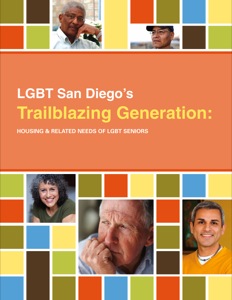Our seniors helped make our LGBT community what it is today, but they are more than just part of our past; they are woven into every part of our community, helping to shape who we are and showing us who we will become. As the first generation aging as an openly LGBT population, they are breaking new ground and teaching us a great deal about the lives of our LGBT seniors.
 The list of community recommendations here is excerpted from the recent survey of the needs and circumstances of San Diego’s LGBT seniors. It’s a partial listing (part two of a three-part series) that addresses only some of the identified needs. The final segment will follow in the next column.
The list of community recommendations here is excerpted from the recent survey of the needs and circumstances of San Diego’s LGBT seniors. It’s a partial listing (part two of a three-part series) that addresses only some of the identified needs. The final segment will follow in the next column.
Recommendations for San Diego LGBT seniors part 2 of 3 from LGBT San Diego’s Trailblazing Generation: Housing & Related Needs of LGBT Seniors. Increase the visibility and availability of information regarding retirement/aging planning for the LGBT community, particularly those ages 50 to 62.
The data from this study clearly indicates that in their struggle for survival and for equal treatment, many LGBT Americans have been unable to turn their attention to the planning necessary for their own retirements and aging process. Increased availability of the information necessary for LGBT community members to adequately plan for their own housing, medical care, support systems and financial needs might help to address the challenges currently facing community members in the future.
LGBT senior housing recommendations
1. Expand and enhance the cultural competency of existing senior housing providers. Build a network of LGBT affirmative housing providers who, through relationship development, education and skill building, can be encouraged to increase their knowledge and skill with an LGBT senior population at both organizational policy levels and staff service provision levels.
2. Expand the availability and accessibility of LGBT-affirmative senior housing services. These efforts will require three different, income-based initiatives.
a. Identify a low-income, senior housing developer who may be willing to work in partnership with the LGBT community to develop subsidized, affordable, low-income senior housing for LGBT seniors. The income levels required to qualify for such housing are limited to the low end of the annual income spectrum. The demand for such housing greatly exceeds the current supply, particularly in light of the “aging in place” wishes of most seniors, which reduces the turnover rate in such housing. Such a partnership would also likely require the presence of an LGBT-identified community service provider to ensure LGBT affirmative on-site services are available for the LGBT residents.
b. Identify existing low-income, senior housing options for LGBT seniors, including existing landlords or property owners who may be willing to work in partnership with the LGBT community to expand their affordable offerings to low-income LGBT seniors. The group of seniors whose annual incomes slightly exceed the established cut-offs for subsidized housing find themselves with few options. These LGBT seniors experience the difficult choices created by either using nearly all their monthly income for rent, with very little money left over each month for other budgetary requirements, such as utilities, food, supplies and prescription drugs, or moving to geographic areas where they often fear for their safety or feel isolated. An increased supply of LGBT-affirmative affordable housing is needed for lower income LGBT seniors.
c. Identify existing market-rate senior housing communities who may be interested in the further development of market rate housing or retirement communities for LGBT seniors. While higher income seniors may have more options than other groups regarding housing and related needs, these seniors continue to seek housing options that do not return them to isolation or invisibility.
3. Develop an LGBT-affirmative listing (electronically and in print media) of safe, affordable senior housing options. As options and partnerships develop it is important that LGBT seniors have easy-to-access information regarding the options available to them.
In this column and the one preceding it, we’ve touched on housing, medical, mental health, social and recreational needs. The next column will give an overview of policy recommendations designed to reform laws to give LGBT seniors the same protections and benefits that non-LGBT seniors enjoy.







